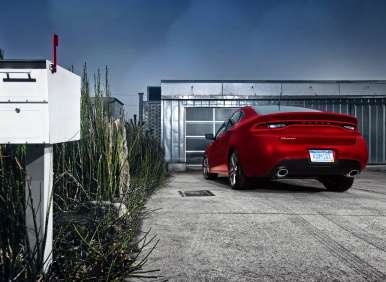Recent Articles
Popular Makes
Body Types
2013 Dodge Dart Rallye: Quick Car, Quick Review
Turbocharged Engine Out-torques the Competition
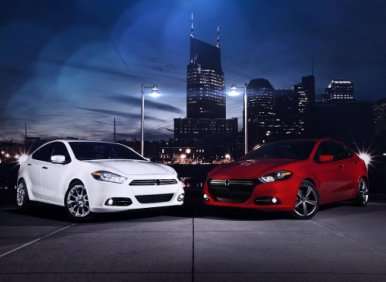
Your intrepid Autobytel correspondent recently ventured to Chrysler’s proving ground in the wilds of Chelsea, Michigan, and he brings back good news about the 2013 Dodge Dart Rallye: At least when configured with its available turbocharged I4 engine with MultiAir technology, the Dart Rallye is a very sharp choice in the compact sedan segment.
What that Fiat-developed MultiAir system does is to enable the engine’s intake valves to optimize airflow for improved power and fuel efficiency; as a result, engineers were able to squeeze 160 hp and 184 lb.-ft. of torque from just 1.4 liters of displacement—although, of course, turbocharging helps as well. That’s the same number of horses available in the Dart’s standard 2.0-liter I4 engine, but with an additional 36 lb.-ft. of twist, and it’s available from 2,500 rpm. Just as important—even with gas prices coming down—is the fact that the MultiAir powerplant helps the 2013 Dodge Dart Rallye deliver EPA ratings of 27 mpg city/39 mpg highway/32 mpg combined with a six-speed manual transmission or 27 mpg city/37 mpg highway/21 mpg combined with a new dual-clutch six-speed automatic.
Those numbers add up to some serious advantages on paper, and the car's actual on-the-road performance—albeit with a very small sample size—more than lived up to its hype.
2013 Dodge Dart Rallye: On the Road, Part I
I drove the 2013 Dodge Dart Rallye with the MultiAir turbo and six-speed manual transmission on two different courses: The first is normally used by Chrysler to evaluate how vehicles deal with rough road surfaces, and also provided an opportunity to get up to (and maybe a little beyond) highway speeds. Here, the Dart was a pleasant surprise, thanks in part to a Euro-style suspension that provided more confidence than that of a typical compact but without the harshness that sometimes comes with a truly sport-tuned setup. This was no luxobarge, absorbing bumps the way a sponge absorbs water, but it did strike a nice balance between comfort and capability.
The Dart Rallye felt fairly well planted on the road, too, even at 75 mph, and not much in the way of intrusive wind noise made it into the cabin. Credit Dodge (and Alfa Romeo) engineers, who managed to get the Dart’s coefficient of drag down to 0.285, right around the same mark posted by the Chevy Volt.
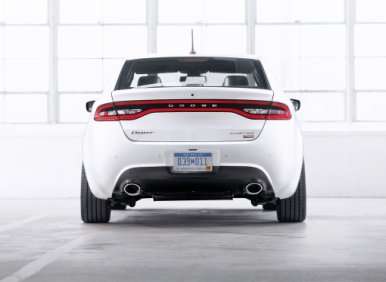
2013 Dodge Dart Rallye: On the Road, Part II
Acceleration was plenty brisk, with a completely unofficial 0-60 time in the low 8-second range, and frankly, going just by the seat of my pants, it felt quicker than the FIAT 500 Abarth I also drove that day (although it really wasn’t). And this is where the Dart’s 184 lb.-ft. of turbocharged torque come into play. Although the Dart is one of the heavier entries in the compact sedan class, it’s also one of the torquiest, with more twisting power on tap than in a Honda Civic Si sedan, or a Scion FR-S, for that matter. The turbocharged Dart Rallye isn’t going to be able to keep up with something like a Mazdaspeed3 or Focus ST, but it will cost thousands of dollars less while achieving a 14-mpg advantage against the Mazda on the highway, as well as a 7-mpg bonus over the Ford in the same category.
The Dart Rallye also performed admirably on the second Chrysler driving loop—a twisty road-course-type circuit developed to evaluate handling. Again, this isn’t going to be a car that satisfies someone looking for a track-ready performer right out of the box, but body roll was minimal for its class, the transmission shifted smoothly and quickly, and that turbo torque was always ready to provide a sharp kick when accelerating out of the turns—which it also steered through with notable aplomb. The seat bolstering, while fairly extensive, could have been firmer, though.
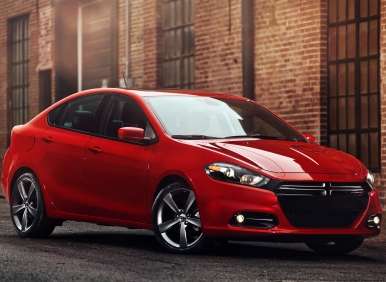
2013 Dodge Dart Rallye: Style Report
The 2013 Dodge Dart Rallye shows off a slightly edgier look than the entry-level Dart SE model, primarily as a result of a blackout-style front end that provides black fascia accents and headlamp bezels for a more sinister appearance. Projector fog lamps are standard as well, while the rear of the Rallye gets an integrated dual-exhaust system with bright-tipped outlets, along with a black lower valance that delivers a visual echo of the front of the car. Inside, drivers will enjoy a standard leather-wrapped steering wheel with integrated audio controls and striped, premium-cloth sport seats with side bolstering.
Overall, the enhancements are subtle but effective, particularly when matched with the new Dodge family LED rear accent lights and two-tone cabin appearance. For those who haven’t sat in a new Dart yet, the car follows a growing trend toward using bright accent colors to set off its cabin instead of emphasizing wood or metallic trims. The result is seriously eye-catching, although the Citrus highlights definitely overpowered the Diesel Grey main color in the car I drove.
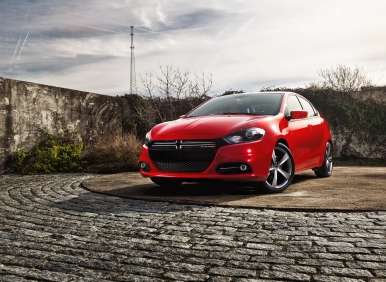
2013 Dodge Dart Rallye: Picking the Nits
There were a couple of areas, however, in which the Dart Rallye did not impress:
Pedal placement—Both the clutch and the brake pedals were uncomfortably high, with more travel than some drivers are going to prefer, especially in the stopping department.
Seats—The fronts are sport seats, but they aren’t as supportive as they look and one of the seams made for an uncomfortable wrinkle behind my lower back.
Rearview mirror—I didn’t get a chance to take any measurements, but the rearview mirror didn’t seem as wide as in vehicles from other automakers; this was something I noticed in quite a few Chrysler Group products.
Cabin colors—The interior of the Dart Rallye was a two-tone affair, in Diesel Grey and Citrus, but the latter really dominated the former and made it look kind of tacky.
Curb weight—The Dart Rallye with a manual transmission is listed at 3,191 lbs., making the heaviest car in its class, in some cases by hundreds of pounds; even the Chevy Cruze, from a brand known for heavy cars, tops out below the lightest Dart. As enjoyable as the Dart was to drive, it would be that much more fun if it went on a diet.
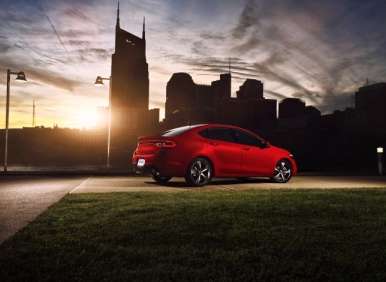
2013 Dodge Dart Rallye: Ranking the Rivals
As mentioned, the Dodge Dart Rallye with its optional turbocharged I4 engine occupies a singular place in the U.S. automotive landscape. It isn’t—and wasn’t meant to be—some kind of hi-po pocket rocket, but it does deliver a noticeably more dynamic driving experience than the run-of-the-mill grocery getters from the compact segment, while still achieving superior fuel-efficiency ratings. Here’s where the Dodge fits in among some of the next-gen competition, ranked by torque:
- Mazdaspeed3 (hatchback, turbo)—$24,000; 263 hp/280 lb.-ft. of torque; 18/25/21
- Ford Focus ST (hatchback, turbo)—$23,700; 252 hp/270 lb.-ft. of torque; EPA ratings unavailable
- VW Jetta GLI (with turbo)—$23,475; 200 hp/207 lb.-ft. of torque; 22/33/26
- Dodge Dart Rallye (turbo)—$20,295; 160 hp/184 lb.-ft. of torque; 27 mpg city/39 mpg highway/32 mpg combined
- Honda Civic Si sedan—$22,555; 201 hp/170 lb.-ft. of torque; 22/31/25
- Kia Forte (with 2.4-liter I4)—$19,100; 173 hp/168 lb.-ft. of torque; 22/32/26
- Chevy Cruze (with turbo)—$18,555; 138 hp/148 lb.-ft. of torque; 26/38/30
- Mazda3 sedan (with Skyactiv)—$18,700; 155 hp/148 lb.-ft. of torque; 28/40/33
- Ford Focus—$16,500; 160 hp/146 lb.-ft. of torque; 28/38/31
- Hyundai Elantra—$16,695; 148 hp/131 lb.-ft. of torque; 29/40/33
